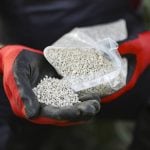
Tag Archives Phosphorus

Fertilizer label changes called costly, unnecessary
Canada’s bulk fertilizer makers now have until July 2026 to update their labels, but industry says the rules will be expensive to implement and won’t actually provide safety gains

Manitoba flags U.S. mega-dairy plans for international review
Manitoba government worries two massive proposed dairy projects in North Dakota will add nutrient loading to an already at-risk Lake Winnipeg

Bourgault test drives deep-banded phosphorus
At its test sites, the manufacturer is setting P deep down in soil to see if plants can access it throughout the season

Organic farms need soil testing too
Organic farmers should take a lesson from conventional farming when it comes to testing for soil nutrients and benchmarking fields frequently: University of Manitoba researcher

Struvite fertilizer from Winnipeg sewers
City wastewater upgrades will include equipment to ‘upcycle’ phosphorus

Nutrient reduction targets launched for Manitoba waterways
New regulations set out how much nitrogen and phosphorus should be coming into Lake Winnipeg

On the hunt for Lake Winnipeg’s phosphorus problem
Citizen science initiative aims to help pinpoint sources of Lake Winnipeg’s excess nutrients
Opinion: Sleepwalking into a phosphorus crisis
Mined phosphorus is a key to the food system but it’s in limited supply

Rethinking phosphorus acid and phototoxicity
Most leaf damage is cosmetic, not yield-busting, according to recent trials

Phosphorus boosters and broad-spectrum antifungal found in Prairie soils
Researchers say naturally occurring microbes can make phosphorus more readily available


